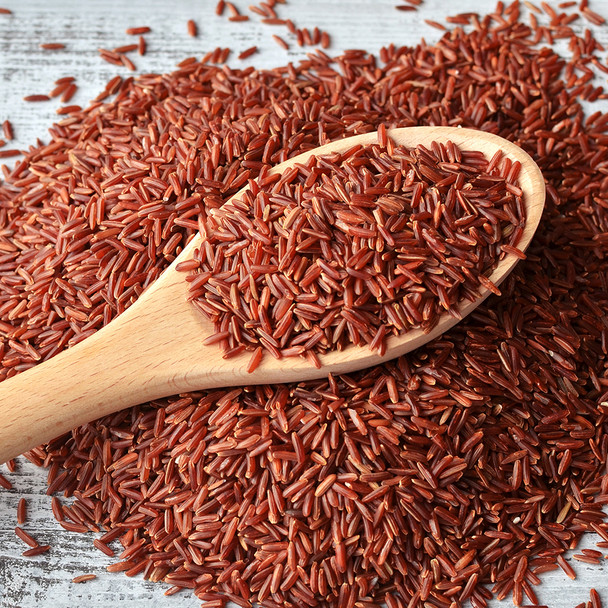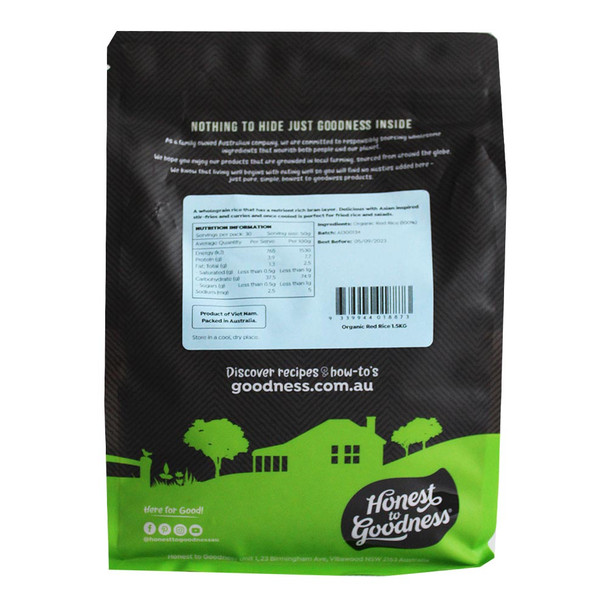Red rice is a kind of 'unpolished' rice, retaining a higher nutritional value compared to white rice or even polished rice.
The 'unhulled' nature retains the red bran layer, making it richer in fibre than a white (hulled) rice, with a flavour that's significantly more powerful and complex, tasting more nutty, earthy and 'full'.
The red bran layer contains up to 95% of the dietary fibre and minerals (iron, zinc, potassium, sodium, manganese) of the whole rice, whereas the inner white portion contains predominantly carbohydrate and proteins.
Red rice works well with a number of foods and also eaten by itself, and can be included in risotto and other combined rice dishes.
HOW TO USE
Red rice can be used anytime you might choose a white rice instead. It is very popular in all Asian dishes or anytime rice serves as an accompaniment. Grest for stir fries and sushi (great in lunchboxes to sustain energy).
Cooking red rice is easy and similar to cooking other forms of rice.
To keep the rice from becoming sticky when cooking, rinse & swirl then drain in cold water prior to cooking to remove some of the extra starch on the surface. To prepare, combine rice and water or stock (1 cup rice to 2 1/4 cups water or stock) in a saucepan over medium-high heat. Once boiling, cover it and reduce the heat to a simmer. Stor occasionally to prevent sticking, Cook the rice for 30–35 minutes until tender, chewy, and all the liquid has been absorbed. Remove the pan from the heat and let the rice sit for 5 minutes before removing the lid. Use a fork to help fluff rice before serving..
GROWING & PROCESSING
Product of Vietnam. 100% certified organic.
INGREDIENTS
Organic Red Rice (100%)








Red rice is a kind of 'unpolished' rice, retaining a higher nutritional value compared to white rice or even polished rice.
The 'unhulled' nature retains the red bran layer, making it richer in fibre than a white (hulled) rice, with a flavour that's significantly more powerful and complex, tasting more nutty, earthy and 'full'.
The red bran layer contains up to 95% of the dietary fibre and minerals (iron, zinc, potassium, sodium, manganese) of the whole rice, whereas the inner white portion contains predominantly carbohydrate and proteins.
Red rice works well with a number of foods and also eaten by itself, and can be included in risotto and other combined rice dishes.
HOW TO USE
Red rice can be used anytime you might choose a white rice instead. It is very popular in all Asian dishes or anytime rice serves as an accompaniment. Grest for stir fries and sushi (great in lunchboxes to sustain energy).
Cooking red rice is easy and similar to cooking other forms of rice.
To keep the rice from becoming sticky when cooking, rinse & swirl then drain in cold water prior to cooking to remove some of the extra starch on the surface. To prepare, combine rice and water or stock (1 cup rice to 2 1/4 cups water or stock) in a saucepan over medium-high heat. Once boiling, cover it and reduce the heat to a simmer. Stor occasionally to prevent sticking, Cook the rice for 30–35 minutes until tender, chewy, and all the liquid has been absorbed. Remove the pan from the heat and let the rice sit for 5 minutes before removing the lid. Use a fork to help fluff rice before serving..
GROWING & PROCESSING
Product of Vietnam. 100% certified organic.
INGREDIENTS
Organic Red Rice (100%)













 Honest to Goodness
Honest to Goodness







